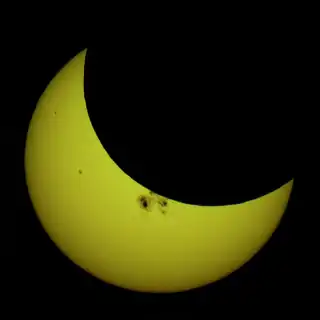Solar eclipse of August 12, 2045
A total solar eclipse will occur on Saturday, August 12, 2045, when the Moon passes between Earth and the Sun, thereby totally or partly obscuring the image of the Sun for a viewer on Earth. A total solar eclipse occurs when the Moon's apparent diameter is larger than the Sun's, blocking all direct sunlight, turning day into darkness. Totality occurs in a narrow path across Earth's surface, with the partial solar eclipse visible over a surrounding region thousands of kilometres wide.
| Solar eclipse of August 12, 2045 | |
|---|---|
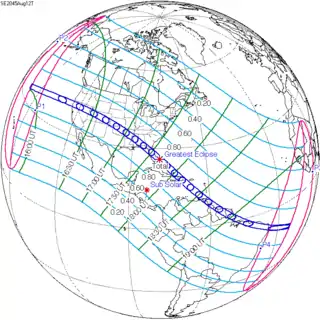 Map | |
| Type of eclipse | |
| Nature | Total |
| Gamma | 0.2116 |
| Magnitude | 1.0774 |
| Maximum eclipse | |
| Duration | 366 s (6 min 6 s) |
| Coordinates | 25.9°N 78.5°W |
| Max. width of band | 256 km (159 mi) |
| Times (UTC) | |
| Greatest eclipse | 17:42:39 |
| References | |
| Saros | 136 (39 of 71) |
| Catalog # (SE5000) | 9608 |
It will be the fourth longest eclipse of the 21st century with a magnitude of 1.0774 occurring just one hour after perigee.[1] It will be visible throughout much of the continental United States, with a path of totality running through northern California, Nevada, Utah, Colorado, Kansas, Oklahoma, Texas, Arkansas, Mississippi, Alabama, and Florida. The total eclipse will be greatest over the Bahamas, before continuing over the Turks and Caicos Islands, Cuba, Dominican Republic, Haiti, Venezuela, Trinidad and Tobago, Guyana, Suriname, French Guiana, and Brazil.
The path of totality of this eclipse will be seen over many major cities, including Reno, Salt Lake City, Colorado Springs, Oklahoma City, Tulsa, Jackson, Montgomery, Tallahassee, Tampa, Orlando, Fort Lauderdale, Miami, Nassau, Santo Domingo, Porlamar, Port of Spain, Georgetown, Paramaribo, Belém, São Luís, Joāo Pessoa and Recife.[2] It will also be the second total eclipse visible from Little Rock in 21.3 years.[2] Totality will last for at least 6 minutes along the part of the path that starts at Camden, Alabama, crossing Florida and ending near the southernmost Bahama Islands. The longest duration of totality will be 6 minutes 5.5 seconds at 25°54.594′N 78°32.19′W, which is over the Atlantic Ocean east of Fort Lauderdale and south of Freeport, Bahamas.[2]
The solar eclipse of August 21, 2017 had a very similar path of totality over the U.S., about 250 miles (400 km) to the northeast, also crossing the Pacific coast and Atlantic coast of the country. This is because when a solar eclipse crosses the U.S. in mid-August at an ascending node (i.e. moves from south to north during odd-numbered saros), the path of the eclipse tracks from coast to coast. When a solar eclipse crosses the U.S. in mid-August at descending node (even numbered saros), the path tracks a large distance southward.[3]
Details of the totality in some places or cities
| Country or Territory | City or Town | Start
of |
Start of total eclipse (Local Time) |
End of total eclipse (Local Time) |
Duration of total eclipse |
End of partial eclipse (Local Time) |
Magnitude |
|---|---|---|---|---|---|---|---|
| Eureka, California | 07:13:02 | 08:14:21 | 08:18:28 | 4 min 07s | 09:25:23 | 1,069 | |
| Redding, California | 07:13:45 | 08:15:43 | 08:20:07 | 4 min 25 s | 09:27:43 | 1,069 | |
| Reno, Nevada | 07:14:41 | 08:18:43 | 08:21:30 | 2 min 46 s | 09:31:21 | 1,070 | |
| Salt Lake City, Utah | 08:20:54 | 09:28:15 | 09:30:32 | 2 min 17 s | 10:43:03 | 1,072 | |
| Colorado Springs, Colorado | 08:27:14 | 09:36:48 | 09:41:54 | 5 min 06 s | 10:55:58 | 1,073 | |
| Oklahoma City, Oklahoma | 09:36:37 | 10:51:13 | 10:54:39 | 3 min 26 s | 12:12:22 | 1,075 | |
| Tulsa, Oklahoma | 09:38:39 | 10:52:22 | 10:57:58 | 5 min 36 s | 12:14:22 | 1,075 | |
| Little Rock, Arkansas | 09:44:40 | 11:00:05 | 11:05:43 | 5 min 38 s | 12:22:42 | 1,076 | |
| Jackson, Mississippi | 09:49:31 | 11:07:44 | 11:11:07 | 3 min 23 s | 12:30:05 | 1,076 | |
| Montgomery, Alabama | 09:56:11 | 11:14:28 | 11:18:51 | 4 min 23 s | 12:36:40 | 1,077 | |
| Tallahassee, Florida | 11:01:35 | 12:20:12 | 12:26:07 | 5 min 55 s | 13:43:20 | 1,077 | |
| Tampa, Florida | 11:07:45 | 12:27:56 | 12:32:53 | 4 min 57s | 13:50:40 | 1,077 | |
| Orlando, Florida | 11:09:09 | 12:28:38 | 12:34:24 | 5 min 46 s | 13:51:17 | 1,077 | |
| Miami, Florida | 11:14:54 | 12:36:43 | 12:39:43 | 3 min 00 s | 13:58:03 | 1,077 | |
| Jensen Beach, Florida | 11:12:59 | 12:32:45 | 12:38:51 | 6 min 6 s | 13:55:27 | 1,077 | |
| Freeport | 11:17:05 | 12:37:08 | 12:42:49 | 5 min 41 s | 13:59:07 | 1,077 | |
| Nassau | 11:21:48 | 12:41:58 | 12:48:02 | 6 min 04 s | 14:03:50 | 1,077 | |
| Providenciales | 11:37:30 | 12:58:48 | 13:01:21 | 2 min 34 s | 14:16:38 | 1,077 | |
| Cap-Haïtien | 11:41:01 | 13:01:02 | 13:06:44 | 5 min 32 s | 14:20:32 | 1,077 | |
| Santo Domingo | 12:47:54 | 14:07:15 | 14:13:01 | 5 min 47 s | 15:25:31 | 1,077 | |
| Porlamar | 13:14:00 | 14:31:31 | 14:34:47 | 3 min 16 s | 15:44:20 | 1,075 | |
| Port of Spain | 13:18:48 | 14:34:13 | 14:39:09 | 4 min 57 s | 15:46:07 | 1,074 | |
| Tucupita | 13:20:52 | 14:38:08 | 14:39:29 | 1 min 21 s | 15:48:42 | 1,074 | |
| Georgetown | 13:31:37 | 14:44:37 | 14:49:33 | 4 min 56 s | 15:54:35 | 1,073 | |
| Paramaribo | 13:38:08 | 14:50:14 | 14:53:13 | 3 min 00 s | 15:57:03 | 1,072 | |
| Apatou | 13:40:28 | 14:52:04 | 14:54:53 | 2 min 49 s | 15:58:46 | 1,071 | |
| Belem, Para | 14:58:25 | 16:05:53 | 16:07:56 | 2 min 03 s | 117:08:20 | 1,069 | |
| Sāo Luis, Maranhāo | 15:04:34 | 16:08:41 | 16:12:41 | 4 min 00 s | 17:10:10 | 1,067 | |
| Joāo Pessoa, Paraíba | 15:17:29 | 16:16:37 | 16:20:02 | 3 min 26 s | 17:13:36 | 1,063 | |
| Recife, Pernambuco | 15:18:22 | 16:17:42 | 16:20:26 | 2 min 44 s | 17:14:15 | 1,063 |
Images
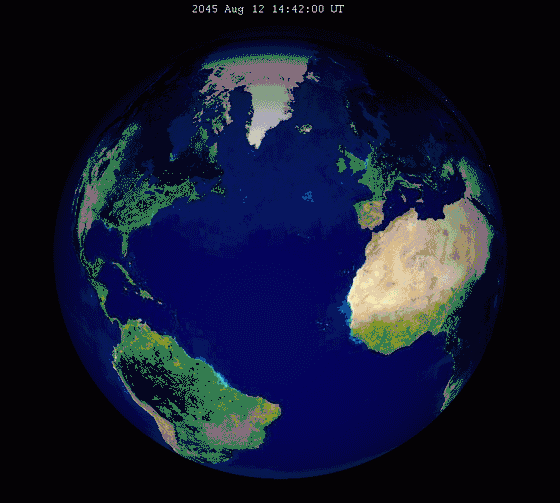
Animated path: Small dark circle represents umbra, much larger grey circle represents penumbra.
Related eclipses
Solar eclipses of 2044–2047
This eclipse is a member of a semester series. An eclipse in a semester series of solar eclipses repeats approximately every 177 days and 4 hours (a semester) at alternating nodes of the Moon's orbit.[4]
| Solar eclipse series sets from 2044 to 2047 | ||||||
|---|---|---|---|---|---|---|
| Ascending node | Descending node | |||||
| 121 | February 28, 2044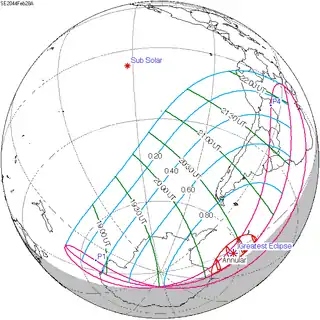 Annular |
126 | August 23, 2044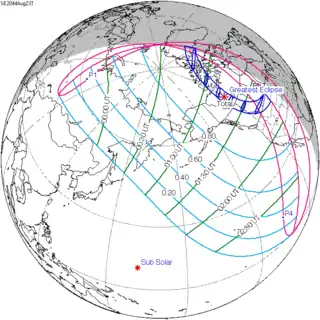 Total | |||
| 131 | February 16, 2045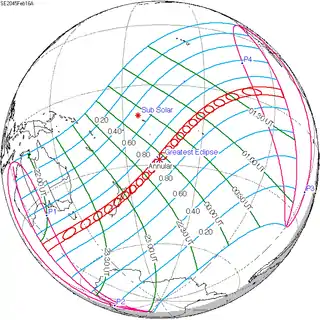 Annular |
136 | August 12, 2045 Total | |||
| 141 | February 5, 2046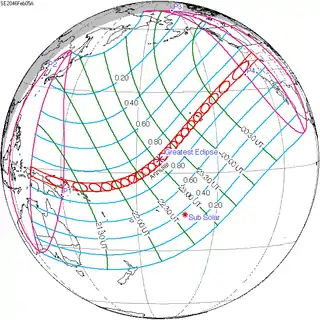 Annular |
146 | August 2, 2046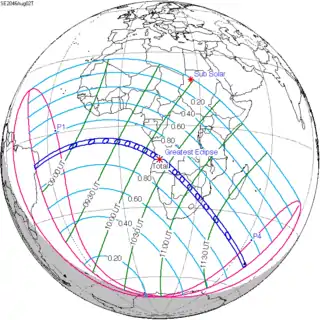 Total | |||
| 151 | January 26, 2047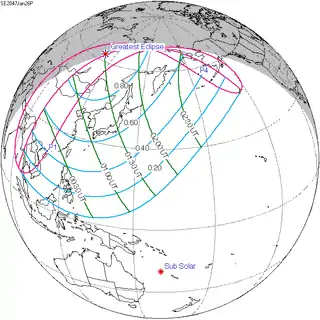 Partial |
156 | July 22, 2047 Partial | |||
| Partial solar eclipses on June 23, 2047 and December 16, 2047 occur on the next lunar year eclipse set. | ||||||
Saros 136
Solar Saros 136, repeating every 18 years, 11 days, contains 71 events. The series started with partial solar eclipse on June 14, 1360, and reached a first annular eclipse on September 8, 1504. It was a hybrid event from November 22, 1612, through January 17, 1703, and total eclipses from January 27, 1721, through May 13, 2496. The series ends at member 71 as a partial eclipse on July 30, 2622, with the entire series lasting 1262 years. The longest eclipse occurred on June 20, 1955, with a maximum duration of totality at 7 minutes, 7.74 seconds. All eclipses in this series occurs at the Moon's descending node.[5]
| Series members 29–43 occur between 1865 and 2117 | ||
|---|---|---|
| 29 | 30 | 31 |
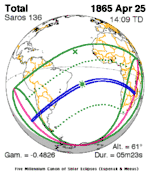 Apr 25, 1865 |
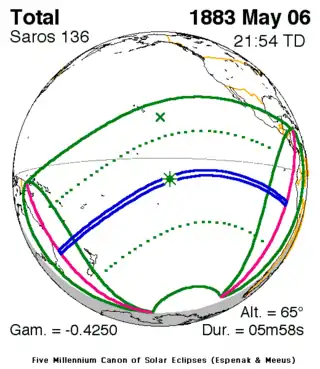 May 6, 1883 |
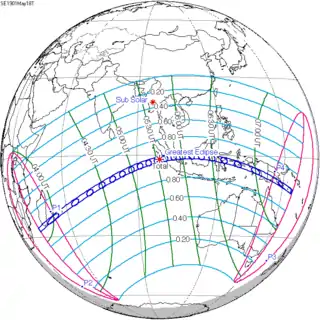 May 18, 1901 |
| 32 | 33 | 34 |
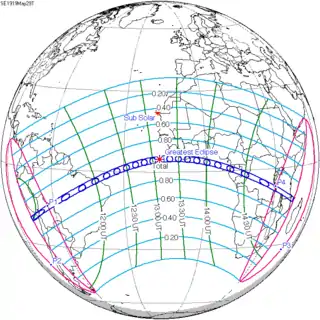 May 29, 1919 |
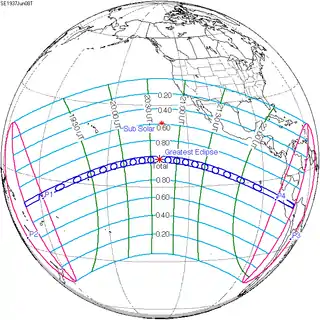 Jun 8, 1937 |
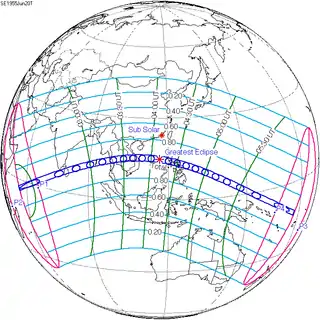 Jun 20, 1955 |
| 35 | 36 | 37 |
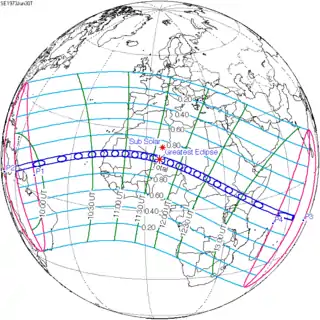 Jun 30, 1973 |
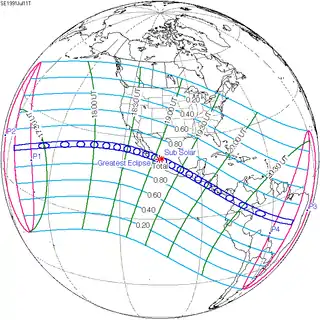 Jul 11, 1991 |
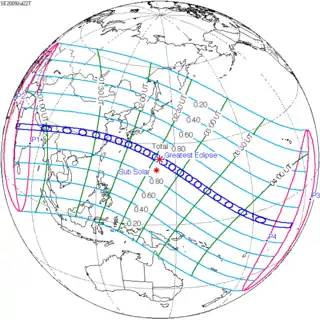 Jul 22, 2009 |
| 38 | 39 | 40 |
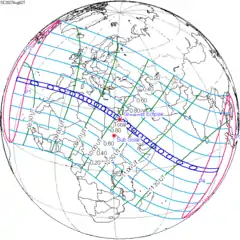 Aug 2, 2027 |
 Aug 12, 2045 |
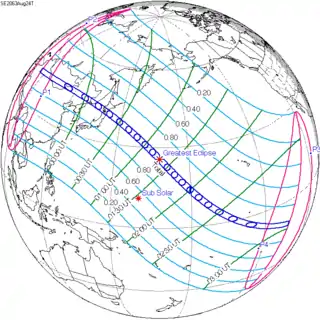 Aug 24, 2063 |
| 41 | 42 | 43 |
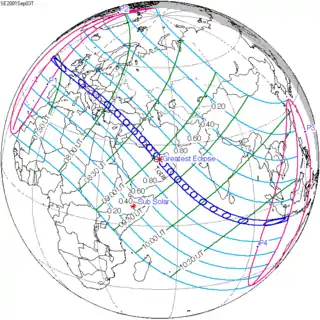 Sep 3, 2081 |
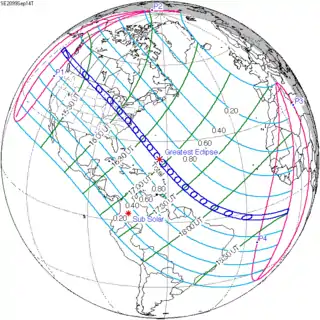 Sep 14, 2099 |
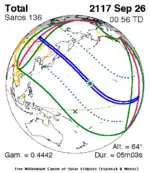 Sep 26, 2117 |
Tritos series
This eclipse is a part of a tritos cycle, repeating at alternating nodes every 135 synodic months (≈ 3986.63 days, or 11 years minus 1 month). Their appearance and longitude are irregular due to a lack of synchronization with the anomalistic month (period of perigee), but groupings of 3 tritos cycles (≈ 33 years minus 3 months) come close (≈ 434.044 anomalistic months), so eclipses are similar in these groupings.
| Series members between 1901 and 2100 | |||
|---|---|---|---|
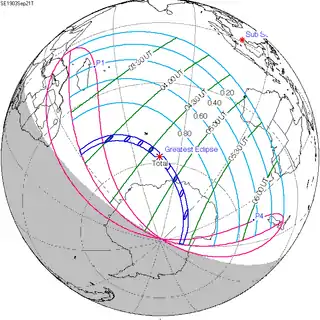 September 21, 1903 (Saros 123) |
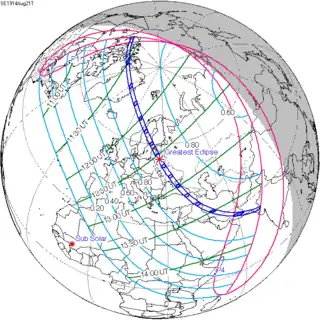 August 21, 1914 (Saros 124) |
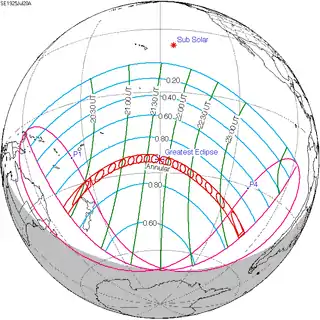 July 20, 1925 (Saros 125) | |
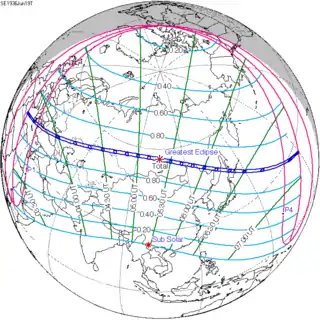 June 19, 1936 (Saros 126) |
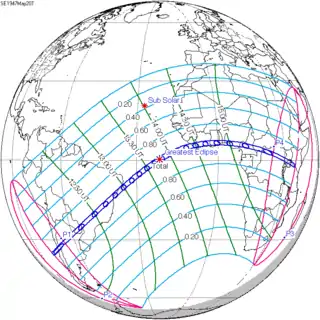 May 20, 1947 (Saros 127) |
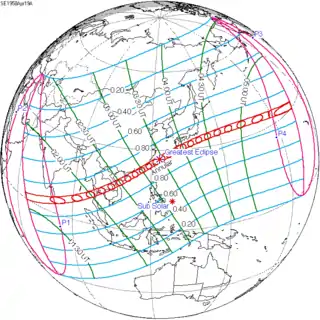 April 19, 1958 (Saros 128) | |
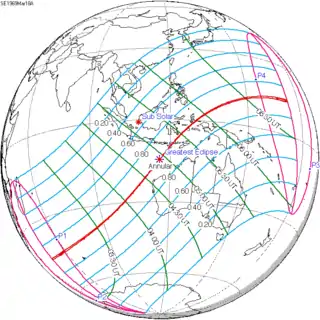 March 18, 1969 (Saros 129) |
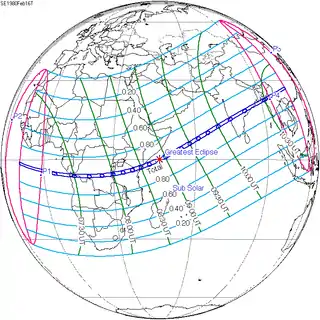 February 16, 1980 (Saros 130) |
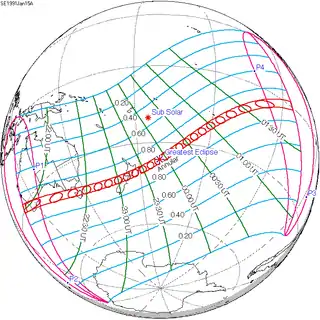 January 15, 1991 (Saros 131) | |
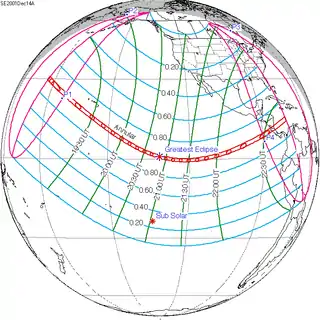 December 14, 2001 (Saros 132) |
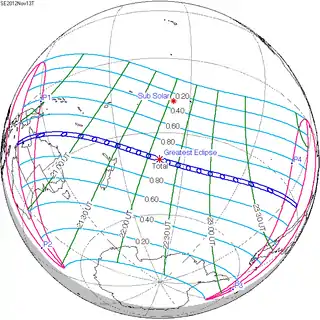 November 13, 2012 (Saros 133) |
 October 14, 2023 (Saros 134) | |
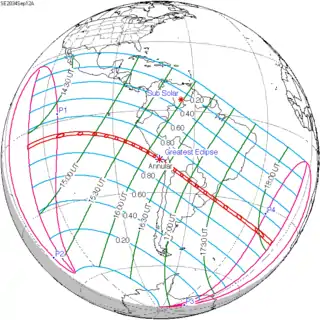 September 12, 2034 (Saros 135) |
 August 12, 2045 (Saros 136) |
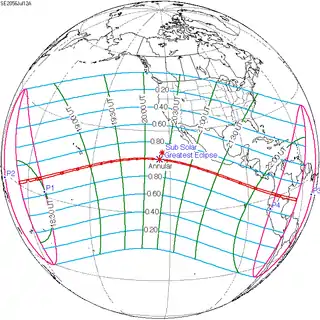 July 12, 2056 (Saros 137) | |
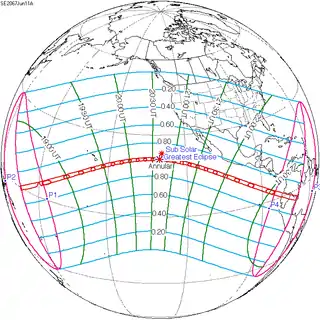 June 11, 2067 (Saros 138) |
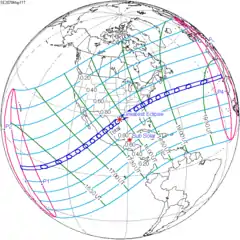 May 11, 2078 (Saros 139) |
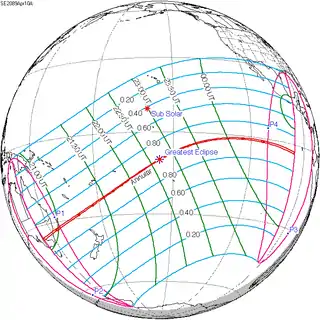 April 10, 2089 (Saros 140) | |
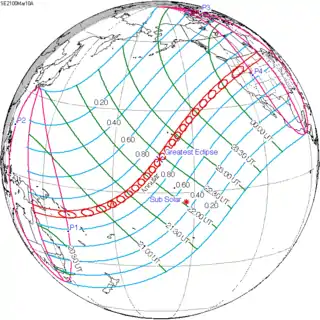 March 10, 2100 (Saros 141) |
|||
Metonic series
The metonic series repeats eclipses every 19 years (6939.69 days), lasting about 5 cycles. Eclipses occur in nearly the same calendar date. In addition, the octon subseries repeats 1/5 of that or every 3.8 years (1387.94 days). All eclipses in this table occur at the Moon's descending node.
| 21 eclipse events between June 1, 2011 and June 1, 2087 | ||||
|---|---|---|---|---|
| May 31 – June 1 | March 19–20 | January 5–6 | October 24–25 | August 12–13 |
| 118 | 120 | 122 | 124 | 126 |
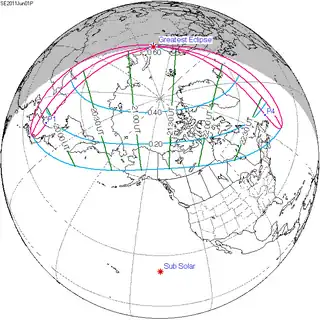 June 1, 2011 |
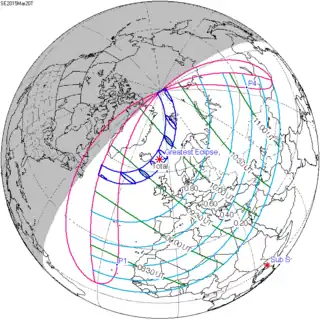 March 20, 2015 |
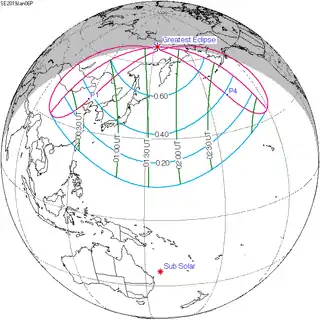 January 6, 2019 |
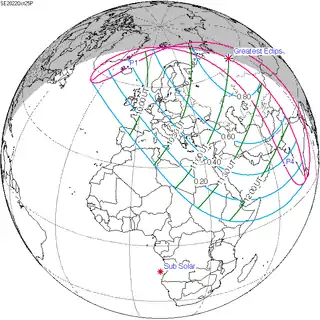 October 25, 2022 |
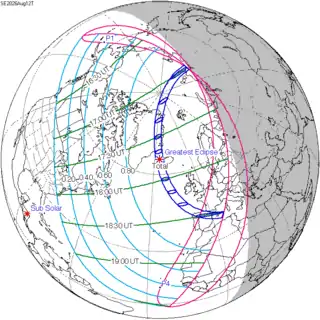 August 12, 2026 |
| 128 | 130 | 132 | 134 | 136 |
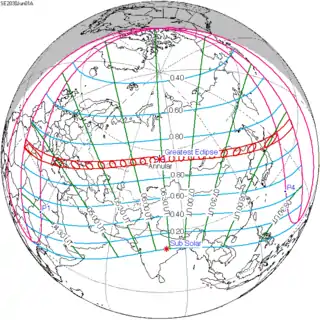 June 1, 2030 |
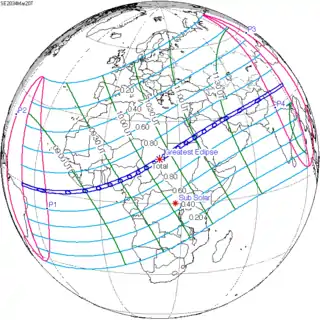 March 20, 2034 |
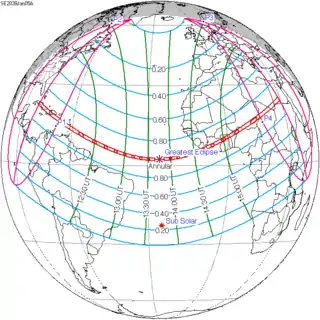 January 5, 2038 |
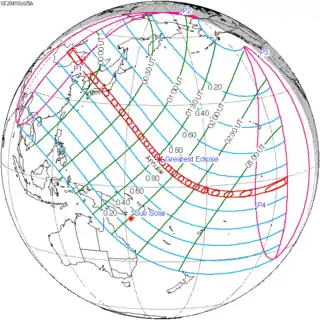 October 25, 2041 |
 August 12, 2045 |
| 138 | 140 | 142 | 144 | 146 |
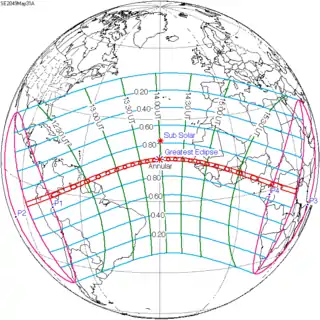 May 31, 2049 |
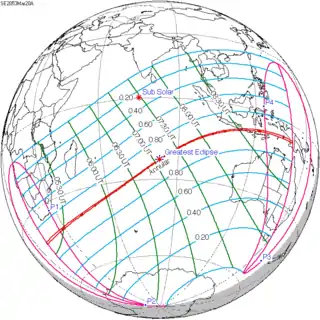 March 20, 2053 |
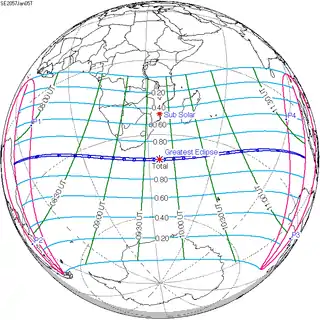 January 5, 2057 |
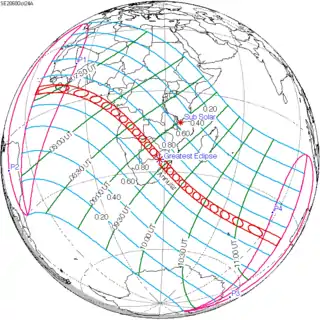 October 24, 2060 |
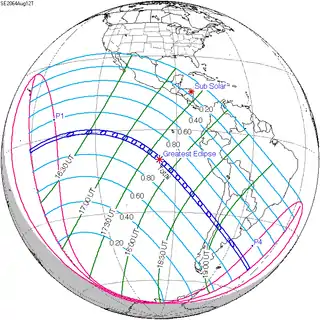 August 12, 2064 |
| 148 | 150 | 152 | 154 | 156 |
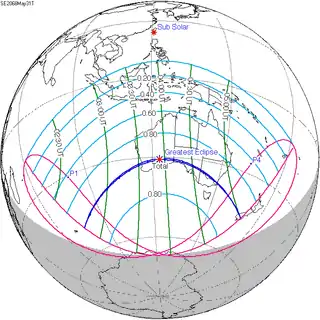 May 31, 2068 |
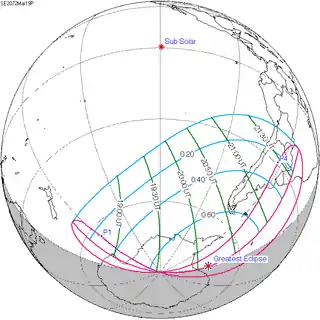 March 19, 2072 |
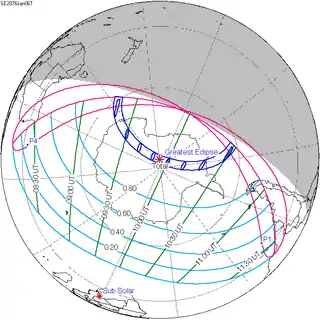 January 6, 2076 |
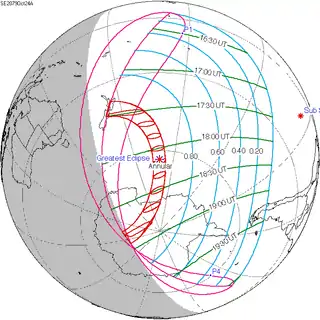 October 24, 2079 |
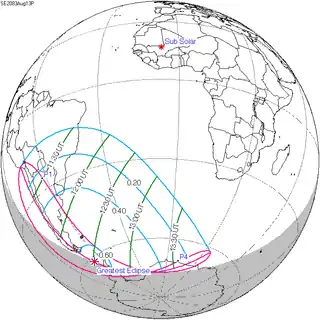 August 13, 2083 |
| 158 | 160 | 162 | 164 | 166 |
 June 1, 2087 |
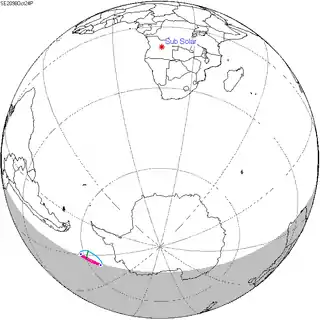 October 24, 2098 |
|||
See also
References
- Walker, John. "Lunar Perigee and Apogee Calculator". www.fourmilab.ch.
- "TOTAL SOLAR ECLIPSE OF 2045 AUG 12".
- Google Earth Gallery for Solar and Lunar Eclipses, Xavier M. Jubier, 2011
- van Gent, R.H. "Solar- and Lunar-Eclipse Predictions from Antiquity to the Present". A Catalogue of Eclipse Cycles. Utrecht University. Retrieved 6 October 2018.
- SEsaros136 at NASA.gov
.jpg.webp)

